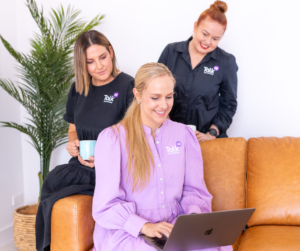As a paediatric speech pathologist, I need to make them repeat the particular sounds many times. Finding fun ways to do this in your sessions can sometimes be tricky. We know that every child is so different and each child is going to respond differently and be motivated by different games and activities. This blog reveals 5 secret ways (or not so secret) to get lots of productions in therapy. These ideas are going to save time when you are planning and hopefully bring fun into your session. As an added bonus, parents might also love the activity and use it at home!
Secret 1: Produce their target wrongly.
My first secret to getting lots more productions is to allow the child to correct my ‘mistake’. For example, when I’m using a play-based activity to practise the ‘l’ sound, I might name the toy “Luke”. Then during the game, I pretend to forget the target sound. I’ll say, “This is … hmmm, what sound are we practising again?” The child says “l”. Then I’ll say, “Oh that’s right, so this boy’s name is… hmmm would it be Wuke or Luke?” The kiddos love being able to correct me! I pretend I need more help with it, so they keep telling me, “Luke! Luke! His name is Luke”. As you can imagine, there are LOTS of times they need to remind me of his name in the one game.
We can do this for grammar goals too. We know that providing a closed choice of the target and the error is an evidence-based cueing strategy. P.S. For a great research study about this, check out Smith-Lock et al., 2015. If they say the error, I ask them, “Wait a second… Is it runned or ran?” They then typically choose the target production. I then hold up my fingers and they have to tell me the correct target again and again and again. I encourage them by saying “I keep forgetting, what did the boy do?” Each time they say the correct target, I put my finger down. This is how I get lots of correct productions in my therapy. This can get a few more production practices in, particularly if the child has decided they don’t want to practise any more. The kiddos just love correcting their speech pathologist!
Secret 2: Play a game with pieces.
I also use games with pieces to get a child to practise their target sounds. Playing a game will always motivate children. I generally use games like the Shopping List Game, Pop Up Pirate, Pop the Pig or Don’t Break the Ice for my speech sound sessions. These games have lots of pieces and create the opportunity for lots of practice. If I am using the Shopping List Game or Pop Up Pirate, I might put the different game pieces on their Minimal Pair or articulation picture cards and they need to practice their target (sound, word or sentence level).
I learned this trick from one of the professional development (PD) workshops I attended.
(Side note, click here for ideas on the best PD courses to attend as an early career speech pathologist.)
Once the child practises 3-5 times (and I provide the necessary feedback), they can then pick up the piece. In the Shopping List game, the grocery item tiles ight be put upside down on their target picture card. The child then practices a few times and turns over a tile (doughnuts) and gives it to the person who needs it. The first person to fill their Shopping List or Pop the Pirate wins.
Pop the Pig has lots of burger colours and a way to randomise the child’s practice is placing these burgers onto their cards. If they roll purple on the dice, they need to practise the word with the purple burger and then feed it to the pig.
In Don’t Break the Ice (or the Kmart equivalent) I will get the kiddo to practice their target sounds and then give them anywhere from 1 to 5 pieces of ice, keeping it random to keep them on their toes. Once they have all the pieces, we play the game. Practising your targets equals a spin of the spinner and a turn to break the ice and win the game.
Each of these games creates some fun competition but also helps motivate the child to keep practising.
Secret 3: Manipulate the activity so that you get more productions in therapy.
When playing games or using toys, I manipulate the activity to ensure the child is getting in practice. This might mean that I randomise how many pieces they get for practising their targets. They might practise their word 3-5 times and get 2 pieces of ice and next time they might get 4 for the game. The game thus goes longer or speeds up depending on the length of your session as well as their practices.
I also love using this for children who are working on things like requesting. I might make sure that the game or activity has lots of pieces so that I can hold onto them to get the kiddo to practise requesting. Also, I choose toys that are tricky to open or have a complex element. This ensures that although there are lots of fun things to play with and use, there is always an opportunity to get productions (speech or language) when they pick up any activity.
Secret 4: Be flexible to get more productions in therapy!
Flexibility also provides another secret way to get lots of productions in your therapy sessions. It is important to remember that sometimes the activity you pick is not going to work for the child. Maybe it did last week but this week it just isn’t cutting it. Always remember to be flexible in your thinking and planning so that you have something up your sleeve and you can get those practices in. Figure out the chid’s motivator and go with it. Going back to the 100 Trials for Speech Sheet or getting the practices wrong can sometimes be all you need to increase their production number. Think about your clients; have a plan B (and depending on the kiddo maybe plan C or even D). Remember, sometimes fun just looks like the child getting 100 speech productions or x number of language productions and then playing a game. The number of times I use activities as a reward or bubbles as the movement breaks in between their productions is too many to count.
Secret 5: Follow Adventures in Speech Pathology
My last secret way to get lots of productions in therapy is to follow “Adventures in Speech Pathology” on Instagram. Rebecca is always posting so many fun and engaging ways to get speech trials. I LOVE using her 100 Trials for Speech sheets. I have about 4 copies laminated in my resource cupboard always ready to go. Firstly, I think about my goals for the session so that I can support the child in their productions. We don’t want them just repeating their words! The children practise their targets and when they get a particular number, they can use a stamp to represent these practices on the sheet (5 practices = 5 stamps). Sometimes stamping the sheets is motivating enough on its own!
My children also love to create a competition with these cards. I draw a line across the page giving us both 50 pictures each. They then practise their words or sentences with the goal of getting more than me. As they mark theirs off, we can start to see who will win. If they win, I then ask them to help me get my 50 practice stamps. This gets at least 50 trials in one activity!
There are lots of ways you can get productions in sessions. I encourage you to open a resource cupboard and think how you can use different activities for speech and language sessions and how exactly they will help you achieve the session goal. Happy practising!







